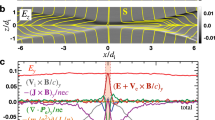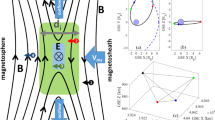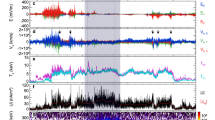Abstract
Magnetic reconnection, the process whereby magnetic field lines break and then reconnect to form a different topology, underlies critical dynamics of magnetically confined plasmas in both nature1,2,3,4 and the laboratory5,6,7,8,9. Magnetic reconnection involves localized diffusion of the magnetic field across plasma, yet observed reconnection rates are typically much higher than can be accounted for using classical electrical resistivity10. It is generally proposed10 that the field diffusion underlying fast reconnection results instead from some combination of non-magnetohydrodynamic processes that become important on the ‘microscopic’ scale of the ion Larmor radius or the ion skin depth. A recent laboratory experiment11 demonstrated a transition from slow to fast magnetic reconnection when a current channel narrowed to a microscopic scale, but did not address how a macroscopic magnetohydrodynamic system accesses the microscale. Recent theoretical models12 and numerical simulations13,14 suggest that a macroscopic, two-dimensional magnetohydrodynamic current sheet might do this through a sequence of repetitive tearing and thinning into two-dimensional magnetized plasma structures having successively finer scales. Here we report observations demonstrating a cascade of instabilities from a distinct, macroscopic-scale magnetohydrodynamic instability to a distinct, microscopic-scale (ion skin depth) instability associated with fast magnetic reconnection. These observations resolve the full three-dimensional dynamics and give insight into the frequently impulsive nature of reconnection in space and laboratory plasmas.
This is a preview of subscription content, access via your institution
Access options
Subscribe to this journal
Receive 51 print issues and online access
$199.00 per year
only $3.90 per issue
Buy this article
- Purchase on Springer Link
- Instant access to full article PDF
Prices may be subject to local taxes which are calculated during checkout



Similar content being viewed by others
References
Paschmann, G. et al. Plasma acceleration at the Earth’s magnetopause: evidence for reconnection. Nature 282, 243–246 (1979)
Mikic, Z., Barnes, D. C. & Schnack, D. D. Dynamical evolution of a solar coronal magnetic field arcade. Astrophys. J. 328, 830–847 (1988)
Colgate, S., Li, H. & Pariev, V. The origin of the magnetic fields of the universe: the plasma astrophysics of the free energy of the universe. Phys. Plasmas 8, 2425–2431 (2001)
Uzdensky, D. A. & MacFadyen, A. I. Stellar explosions by magnetic towers. Astrophys. J. 647, 1192–1212 (2006)
Wesson, J. A. Sawtooth reconnection. Nucl. Fusion 30, 2545–2549 (1990)
Yamada, M. et al. Investigation of magnetic reconnection in a high-temperature tokamak plasma. Phys. Plasmas 1, 3269–3276 (1994)
Bellan, P. M. Spheromaks 60–75 (Imperial Coll. Press, 2000)
Taylor, J. B. Relaxation and magnetic reconnection. Rev. Mod. Phys. 58, 741–763 (1986)
Brown, M. Experimental studies of magnetic reconnection. Phys. Plasmas 6, 1717–1724 (1999)
Yamada, M., Kulsrud, R. & Ji, H. Magnetic reconnection. Rev. Mod. Phys. 82, 603–664 (2010)
Egedal, J. et al. Laboratory observations of spontaneous magnetic reconnection. Phys. Rev. Lett. 98, 015003 (2007)
Shibata, K. & Tanuma, S. Plasmoid-induced-reconnection and fractal reconnection. Earth Planets Space 53, 473–482 (2001)
Che, H., Drake, J. F. & Swisdak, M. A current filamentation mechanism for breaking magnetic field lines during reconnection. Nature 474, 184–187 (2011)
Drake, J. F. et al. Formation of secondary islands during magnetic reconnection. Geophys. Res. Lett. 303, L13105 (2006)
Hsu, S. C. & Bellan, P. M. Experimental identification of the kink instability as a poloidal flux amplification mechanism for coaxial gun spheromak formation. Phys. Rev. Lett. 90, 215002 (2003)
Chandrasekhar, S. Hydrodynamic and Hydromagnetic Stability 464–466 (Dover, 1961)
Gekelman, W. & Stenzel, R. L. Magnetic field line reconnection experiments: 6. Magnetic turbulence. J. Geophys. Res. 89, 2715–2733 (1984)
Srivastava, A. K., Zaqarashvili, T. V., Kumar, P. & Khoachenko, M. L. Observation of kink instability during small B5.0 solar flare on 2007 June 4. Astrophys. J. 715, 292–299 (2010)
Zhou, G. P. et al. Two successive coronal mass ejections driven by the kink and drainage instabilities of an eruptive prominence. Astrophys. J. 651, 1238–1244 (2006)
Berger, T. et al. Magneto-thermal convection in solar prominences. Nature 472, 197–200 (2011)
Liu, C. et al. The eruption from a sigmoidal solar active region on 2005 May 13. Astrophys. J. 669, 1372–1381 (2007)
Kumar, D. & Bellan, P. M. Nonequilibrium Alfvénic plasma jets associated with spheromak formation. Phys. Rev. Lett. 103, 105003 (2009)
Yun, G. S. & Bellan, P. M. Plasma tubes becoming collimated as a result of magnetohydrodynamic pumping. Phys. Plasmas 17, 062108 (2010)
Hsu, S. C. & Bellan, P. M. A laboratory plasma experiment for studying magnetic dynamics of accretion discs and jets. Mon. Not. R. Astron. Soc. 334, 257–261 (2002)
Acknowledgements
This work supported by the US DOE, NSF and AFOSR.
Author information
Authors and Affiliations
Contributions
A.L.M. performed the experiments and analysed data. A.L.M. and P.M.B. discussed and interpreted the results and wrote the manuscript.
Corresponding author
Ethics declarations
Competing interests
The authors declare no competing financial interests.
Supplementary information
Supplementary Figures
This file contains Supplementary Figures 1-5 with legends. They are fast camera images that show helical plasma geometry and plasma filament breaking; EUV diode data and capacitively coupled probe data highlight the difference in reconnecting and non reconnecting plasmas; fast camera image shows hydrogen does not reach miscrocale. (PDF 3175 kb)
Supplementary Movie 1
This movie shows an overview of the experiment: the plasma jet grows and then undergoes first a kink instability and then a Rayleigh-Taylor instability before reconnecting. (MOV 1143 kb)
Supplementary Movie 2
This movie version of Figure 3 shows the kink instability and Rayleigh-Taylor instability in greater detail. (MOV 577 kb)
Rights and permissions
About this article
Cite this article
Moser, A., Bellan, P. Magnetic reconnection from a multiscale instability cascade. Nature 482, 379–381 (2012). https://doi.org/10.1038/nature10827
Received:
Accepted:
Published:
Issue Date:
DOI: https://doi.org/10.1038/nature10827
This article is cited by
-
Generation of laboratory nanoflares from multiple braided plasma loops
Nature Astronomy (2023)
-
Current Sheets, Plasmoids and Flux Ropes in the Heliosphere
Space Science Reviews (2021)
-
Dynamic formation of stable current-driven plasma jets
Scientific Reports (2019)
-
The magnetic Rayleigh–Taylor instability in solar prominences
Reviews of Modern Plasma Physics (2018)
-
Achieving a long-lived high-beta plasma state by energetic beam injection
Nature Communications (2015)
Comments
By submitting a comment you agree to abide by our Terms and Community Guidelines. If you find something abusive or that does not comply with our terms or guidelines please flag it as inappropriate.



